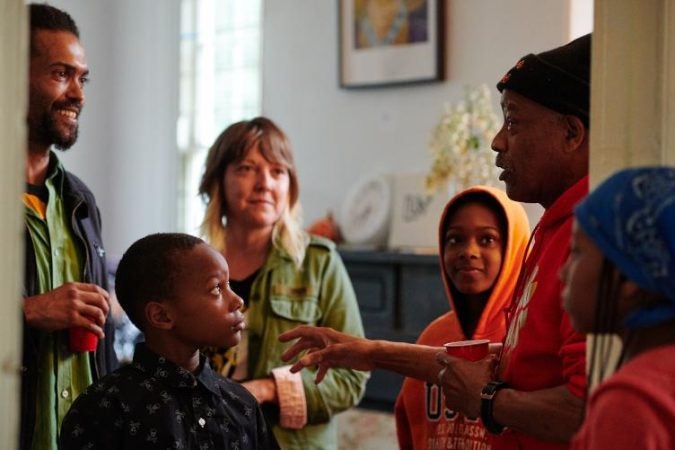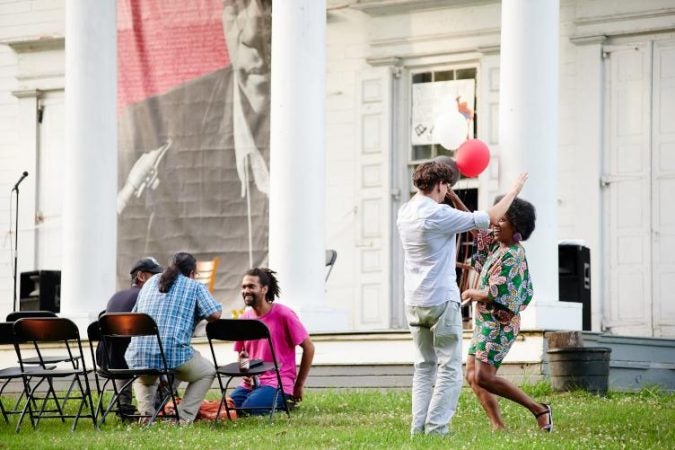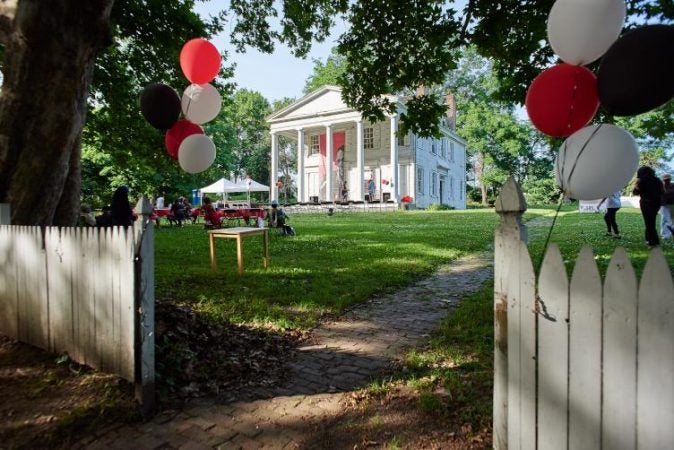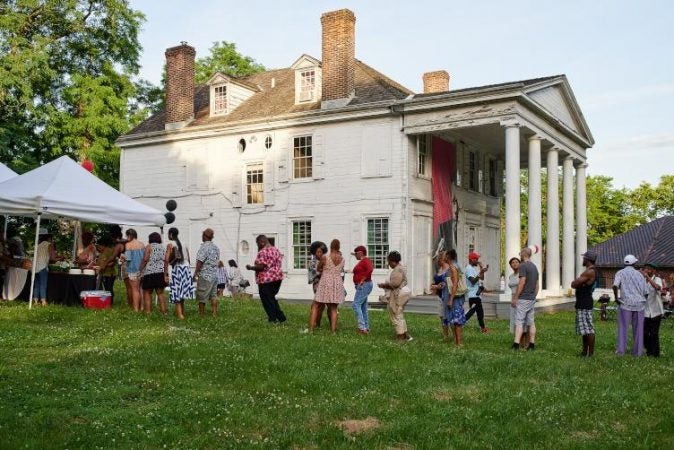Fairmount Park gave artists the keys to a historic mansion. One year later, they aren’t leaving.
Hatfield House has become a hub for artists within the last year, but it still hasn't become a community space for all of Strawberry Mansion.
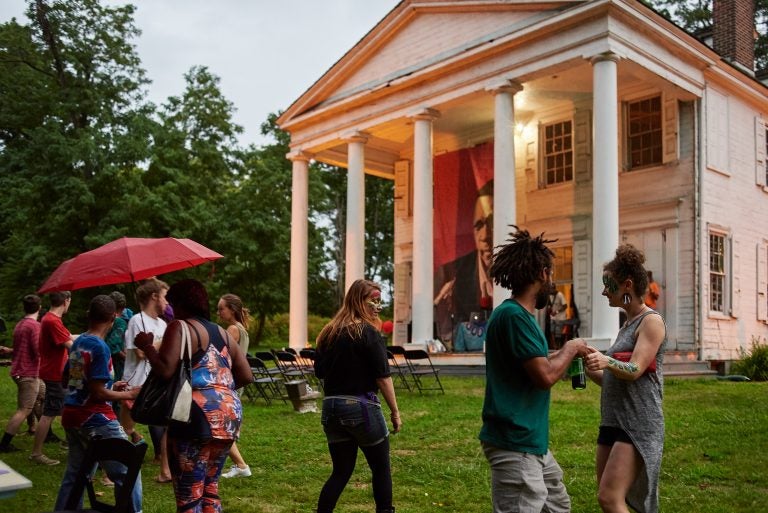
Strawberry Mansion residents mingle on the lawn of the Hatfield House at an art and storytelling event hosted by Amber Art and Design in July. (Albert Yee for Fairmount Park Conservancy)
This story originally appeared on PlanPhilly.
—
An hour before guests arrive for the final art exhibition of the summer at the Hatfield House on the eastern edge of Fairmount Park, Shirley Slaughter is oscillating between the kitchen and the refreshments table.
Slaughter, a longtime Aramark events worker in her 60s, maneuvers deftly around the historic house with platters in her hand, blue and green streamers hanging down from the ceiling above her. She navigates the space as if it’s her own personal parlor. That commanding ease, however, is new. Slaughter has spent most of her life just a short walk away from the 18th century Greek Revival mansion on the corner of 33rd Street and Girard Avenue. Not until recently had she ever set foot inside.
Owned by the city and managed by the Fairmount Park Conservancy, Hatfield House has been a part of Strawberry Mansion since 1930 when the 1760-built structure was dismantled and moved from its original location in Nicetown to the edge of the park. Yet the ties between the house, which sits behind a white picket fence, and the community have never been strong. Most people, like Slaughter, have never ventured beyond the fence.
“I thought it was haunted,” said Tonetta Graham, director of the Strawberry Mansion Community Development Corporation.
For Slaughter, keeping her distance had more to do with a feeling that’s prevalent in Strawberry Mansion.
“Many people in this area don’t feel the park is for them,” Slaughter said in a recent interview. Slaughter pointed to theDiscovery Center, a newly built privately operated environmental education and bird watching center opening later this month on a leased slice of parkland overlooking East Park Reservoir, where many Strawberry Mansion residents grew up playing.“Bird watching is something that we don’t do.”
How Slaughter came to be one of the Hatfield House’s regular events organizers — negotiating with food vendors, outfitting the space and sometimes even cooking herself — is a story that began a year ago with a first-of-of-its-kind arts residency that has succeeded in ways that few observers would have predicted at its launch.
The unique endeavor, dubbed the Community Catalyst residency, is as much about artistic production as it is a new approach to community engagement by the nonprofit conservancy that supports Philadelphia’s public parks. The parks organization, teaming with the Philadelphia-based collective, Amber Art and Design, wanted more than just a protracted pop-up for a moment in time they see as pivotal in the history of Strawberry Mansion. They imagined an accessible space that could serve as a think tank for the community to air out opinions on neighborhood developments; a meeting space that could play host to not just art exhibitions, but also activist roundtables and a newly formed advisory committee.
“We want to be the beacon that fields conversations with the community, and then share those ideas,” said Keir Johnston, co-founder of Amber Art and Design. Johnston and the other artists that are part of Amber set up shop in the house last September. Twelve months later, with the support of their nonprofit landlord and partner, they have turned the local landmark into a safe space for sensitive conversations about the changes that have brought rising real estate values and a growing population of middle-class residents into a neighborhood that hadn’t seen either in decades. At times, the discussion has candidly included critiques of the conservancy itself.
“Something that’s culturally relevant”
Graham, the CDC head, who rarely went near Hatfield before last fall now visits the elegant mansion every six weeks for meetings of the advisory committee, which is helping to steer the direction of future conservancy investments in the neighborhood. These conversations are long overdue and much needed, said Slaughter.
“This neighborhood is a case of the haves and the have-nots; you see one extreme to the other,” Slaughter said. “A lot of folks have been limping around, emotionally damaged.”
The Fairmount Park Conservancy is supporting the work happening at Hatfield with a grant from ArtPlace America, a consortium of funders supporting creative placemaking efforts and innovative community-engagement strategies across the United States. Other projects supported by Artplace America include the equitable development plan surrounding Washington D.C.’s 11th Street Bridge Park — a $45 million High Line-esque park that has received praise for how it has included community residents in its planning process and advanced affordable housing development in its gentrifying Anacostia neighborhood. As part of the ArtPlace America grant, members of the Amber team and Conservancy staff met with Bridge Park planners in D.C. and learned about their ongoing work.
Amber’s one-year residency accounts for a fraction of the ArtPlace America grant, which totals $3 million. In total, about $100,000 comprised the budget for the first year of the residency. The $100,000 covered artists’ fees, events and the hiring of a project manager and an ethnographer as well as light repairs to the kitchen and bathroom.
One of the projects the ethnographer, anthropologist Beth Uzwiak, helped with was an extensive “cultural asset mapping.” The project explored the ways in which Strawberry Mansion residents perceive and use various neighborhood amenities, deduced from dozens of hours of conducting oral histories and interviews. The mapping will likely come in handy as the conservancy pushes forward with new initiatives aimed at better connecting the park to the neighborhoods just beyond its boundaries. One of these is the Mander to the River pedestrian corridor project that will eventually connect Mander Rec Center at 33rd and Diamond to the Schuylkill River Trail. The new connection will be an attractive amenity for residents old and new, and some in the area worry it will push up property values that are already climbing, and lead to displacement. For the conservancy, there is a value in creating a place for conversations to happen.
“[The ArtPlace grant] gave us an opportunity to see ourselves not just as park stewards, but in the community development role,” said Ellen Ryan, the conservancy’s senior director of strategy and planning. “There has always been an openness, an exploratory part of this project. A lot of the process has been about inquiry.”
Other byproducts of the $3 million grant include the new neighborhood advisory committee that meets every six weeks at Hatfield House, and a request for proposals seeking a conceptual design to transform the grounds around Mander Recreation Center. The RFP was released only to architecture and planning firms led by principals of color. An interpretive art installation for the nearby Boxers’ Trail, currently in development, also came out of from the ArtPlace America grant. So, too, did the production of Strawberry Mansion-themed playing cards — featuring important landmarks and figures who hailed from the neighborhood, like radio icon Mary Mason and jazz legend John Coltrane — decks of which were given out during a recent neighborhood celebration.

But beyond these concrete achievements, the project has generated less tangible results. It has encouraged the Fairmount Park Conservancy to take an open-ended approach to the work emanating from the Hatfield House. Conservancy leaders have shown a willingness to defer to Amber and the growing group of residents who’ve become regulars.
“It’s been cool to activate that and work with the community to take something that was exclusive and turn it into something that’s really culturally relevant,” said Jamie Gauthier, the conservancy’s executive director. “To some extent, [Hatfield House] has solidified the Conservancy’s role as a parks organization, yes, but also as an organization that’s incorporating arts and culture into our thinking around community development.”
Before Amber moved in, the house had been dormant for years. “Re-engaging with the space has done a lot for us,” Graham said. “It’s helped us maintain a closer relationship with one of Strawberry Mansion’s best resources, which is Fairmount Park, making sure we are connected to the decisions being made so that they are made with us in mind and not only future residents in mind.”
But one year can’t change decades of tensions, and all sides agree the work must continue. The conservancy has already committed to continuing the project. They’ve applied for grant funding from the National Endowment of the Arts to fund the residency for another year, and internally, there are whispers about replicating this sort of arts-based engagement on the western side of the park in the near future.
Johnston said that Amber is also making plans for year two. The artist collective wants to do more programming related to community health at the house, and develop paid work opportunities for community members on the grounds, whether it’s landscaping or building repairs.
“We want the energy of the house and the activation of it to garnish the momentum to get the house renovated,” he said. “It’s been a great year. You’ve seen FPC grow a lot through this process. But this is a five-year project in my mind.”
Slaughter agrees. Although she’s proud of the progress made at the Hatfield House in year one, there’s work to go before it becomes a community space for all of Strawberry Mansion. “The people who’ve participated in programs at Hatfield House in the first year is from a very small area within the neighborhood,” Slaughter said.
She grew up in a pocket of Strawberry Mansion north of Norris Street and west of 32nd Street. That area, an enclave with high home-ownership rates and many intergenerational families, she said, isn’t yet represented enough in the mapping done at Hatfield. “These are families that are still intact and that have a legacy and a foundation in the community, who are still here,” she said. “There are lots of stories that are in the area that still haven’t been touched upon.”
WHYY is your source for fact-based, in-depth journalism and information. As a nonprofit organization, we rely on financial support from readers like you. Please give today.




